Magnolia Trees and Shrubs: Care and Growing Guide (With Pictures)
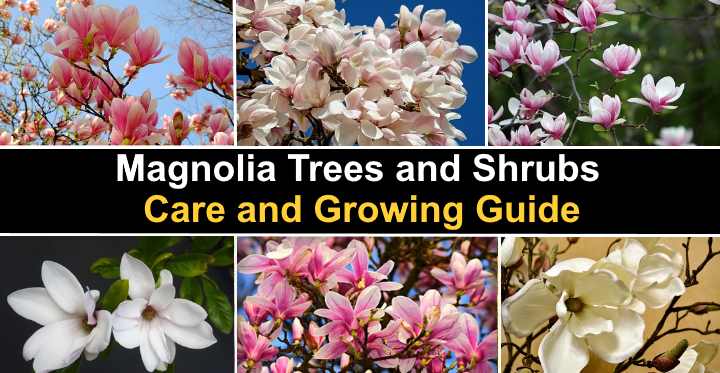
Magnolia is a genus of flowering trees and shrubs that produce stunning white and pink bowl- or star-shaped flowers. Magnolia trees and shrubs are identified by their glossy, leathery leaves, fragrant, showy flowers, and cone-like fruits in the fall. Magnolias are easy to care for, and growing these trees or shrubby plants add beauty to garden landscapes.
There are around 210 species of magnolias in the family Magnoliaceae. Depending on the plant species, magnolias can be evergreen or deciduous trees. Some magnolia trees can be as tall as 90 ft. (25 m) with a spread of 50 ft. (15 m). Magnolia shrubs are large, multi-stemmed bushy plants growing around 15 ft. (4.5 m) high.
Popular magnolia varieties for backyards and garden landscapes include the saucer magnolia (Magnolia x soulangeana) and the shrubby star magnolia (Magnolia stellata). At the end of this article, you will find out about other impressive varieties of magnolias.
This article is a complete care guide to growing magnolia trees and shrubs.
Magnolia Tree Care
To care for magnolia, grow the tree or shrub in well-draining soil, and keep the ground moist. Magnolia trees and shrubs thrive in full sun or partial shade. Fertilize the garden plant in spring when the buds begin to grow. Prune the magnolia after blooming to improve its shape.
Magnolia Flowers

Magnolia fragrant flowers are usually white or various shades of pink
Magnolia flowers are magnificent white or pink flowers that appear in spring. The beautiful flowers are usually in the shape of a star or bowl. The petals can be wide with a pointed tip or long and strap-shaped. The huge, beautiful blooms grow between 8” and 12” (20 – 30 cm) across.
The other impressive feature of large magnolia flowers is their perfume. The fragrant pink or white flowers give off sweet scents reminiscent of honey, sweet candy, or citrus. These delightful fragrances fill backyards when they bloom in early to mid-spring.
How to Choose the Best Type of Magnolia
Varieties of magnolia are suited to growing in most conditions. Although magnolias are common flowering landscape trees and shrubs in the South, some hardy varieties are suitable for yards in northern climates. Also, some varieties bloom in early fall and winter, whereas most are spring-blooming varieties.
Here are some factors to consider when choosing the ideal magnolia for your backyard:
- Landscape use—Magnolias can be large shade trees, evergreen flowering hedge plants, specimen lawn trees, or bushy container shrubs.
- Light—Most species of magnolias need full sun to partial shade to thrive.
- Size of the garden—Check the mature height of the tree or shrub. Magnolias can be enormous trees with an extensive spread. Other cultivars are smaller shrubs or single-stemmed trees suitable for small to medium-sized gardens.
- Climate—Check that the magnolia is cold hardy in the USDA zone where you live. There are magnolia cultivars suitable for most climates.
- Color—Don’t forget to consider the flower color. Although most magnolia flowers are snow-white, magnolia shrubs and trees bloom in lavender, purple, pink, and yellow flowers.
Where to Buy a Magnolia?
You can purchase young magnolia trees for planting in local garden centers, DIY stores, and online. When choosing the best shrub or tree for your front or backyard, pick a magnolia that has room to grow in your backyard and is suitable for the climate.
How to Care for Magnolia Trees and Shrubs
Let’s look in more detail at how to grow a magnolia to boost your garden landscape’s aesthetics.
Where to Plant a Magnolia
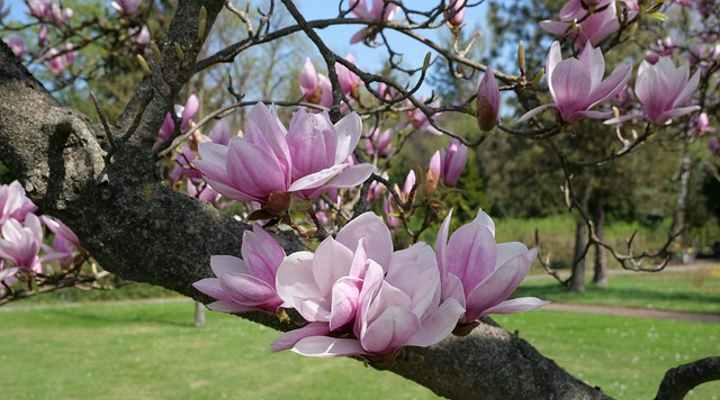
Plant magnolia plants in a sunny location but protected from the hot midday sun
Choose a sunny spot in your garden to plant a magnolia tree or shrub. Although magnolias prefer full sun, they also grow well if they get some shade. If you live in hot climates, then a location where there’s shade from the hot midday and afternoon sun is ideal.
The best location for magnolias to grow should also have protection from the wind. Strong breezes and windy conditions can cause the branches to break and damage the large flowers.
The Best Soil for Growing a Magnolia
Magnolias grow best in soil that has excellent drainage but still holds some moisture. Once established, magnolias are relatively drought-tolerant plants. The good news is that most magnolia species are adaptable to various soil conditions. So, the plants will grow in clay, sandy, loamy, or poor-quality soils.
For healthy growth, the ground should have neutral pH levels. However, magnolias will grow well if the soil is slightly acidic or alkaline. If magnolia leaves start to turn yellow for no reason, check that the ground isn’t too alkaline.
What Time of Year to Plant a Magnolia?
The time to plant evergreen magnolias is in spring. The warm spring weather in Southern states will invigorate growth to help quickly establish the root system. Water the young magnolia tree regularly after planting in spring.
Plant deciduous magnolia trees in early fall in colder, temperate climates. Although growth is slow in winter, the roots will have time to establish themselves. Then by the time warmer weather comes in spring, the magnolia will be ready to burst into bloom with pink or white blossoms.
How to Plant a Magnolia

When planting magnolia trees or shrubs take into consideration factors such as sunlight, soil drainage and enough space
Planting a magnolia is the same as growing any type of flowering tree. Choose the right location to plant the tree where it gets plenty of sunshine, and the ground drains well. Also, ensure there’s enough room for the expansive crown to grow. And don’t forget about the extensive root system—so don’t plant too close to your home.
Here’s how to plant a magnolia:
Remove the upper layer of soil from the magnolia root ball to expose the top root. This allows you to plant the young magnolia tree at the same level it was growing in the container.
Dig a hole 1.5 times larger than the magnolia plant’s root ball, but not as deep. Place the young magnolia tree in the hole, ensuring the exposed upper root is in line with the soil’s surface. Then fill the remaining space with organic-rich soil and firm the earth to get rid of air pockets to make the tree stable.
Give the newly-planted magnolia a thorough watering. Then put a 2-inch (5-cm) layer of mulch around the tree, leaving a few inches gap around the tree trunk. Organic mulch locks in moisture and provides some nutrients when it breaks down. This way, your new magnolia tree doesn’t need fertilization.
How to Water a Magnolia
Water established magnolia trees weekly during the growing season. As a general rule, you need to apply two to three gallons (7.5 – 11 l) of water every week for each 1 inch (2.5 cm) of trunk diameter.
Young magnolia trees require more frequent watering.
After planting the small tree, water it twice a week in temperate climates and three times a week in warm climates. Continue this watering schedule for six months to help establish the plant. After that time, you can reduce watering to weekly during the growing season.
How to Grow Magnolia in Pots
Small magnolia shrubs or dwarf trees are the perfect varieties for growing in containers. You will need a pot that is at least double the size of the root ball. Choose an organic-rich potting mix and amend it with some coarse sand to improve drainage.
Plant the magnolia shrub in the pot so that the soil line is level with the potting mix. Leave about 2 inches (5 cm) from the top of the container so that you can add a layer of mulch.
Water the new magnolia shrub a few times a week for the first few months to keep the soil moist but not too damp. After the magnolia is established, reduce watering the shrub to weekly during the growing season.
It is vital to remember and choose a sturdy container with a drainage hole. Magnolias can grow to be large shrubs or small trees and quickly outgrow their containers.
How to Prune a Magnolia Tree
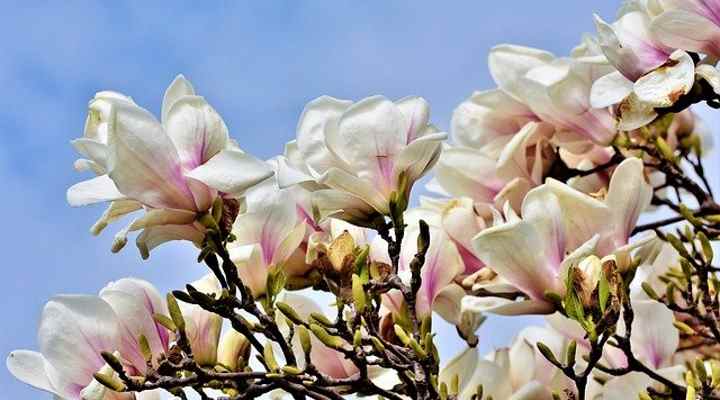
You can prune magnolia trees and shrubs to improve their shape and encourage more flowering
Pruning magnolia trees is useful to shape them as they grow. Pruning these multi-stemmed shrubs can help to train the plant to grow as a specimen tree. Also, regular pruning encourages more blooms. The time to prune magnolias depends on the climate and type of tree.
Prune evergreen magnolias in late spring if necessary. The best way to prune the shrub is to shorten the newer, long branches and remove the main trunk’s lower limbs.
Prune deciduous magnolias in late summer or early fall.
However, it’s good to remember that pruning young evergreen or deciduous magnolias is not always necessary and may result in stressing the plant too much.
Fertilizing a Magnolia Tree or Shrub
Fertilize magnolias once a year with a high-nitrogen, slow-release fertilizer to encourage blooming and healthy growth. The ideal magnolia fertilizer should have three times more nitrogen than phosphorus. Look for a fertilizer that has an NPK rating of 12-4-8 or 20-5-10. The best time to fertilize magnolia trees depends on the type of tree.
Fertilize deciduous magnolias in late fall after the leaves have dropped.
Fertilize evergreen magnolias about one month before the temperature is expected to drop below 40°F (4°C).
You can also fertilize all types of magnolia trees and shrubs in spring before any new growth on the evergreen or deciduous branches.
Propagating a Magnolia Tree from Seeds
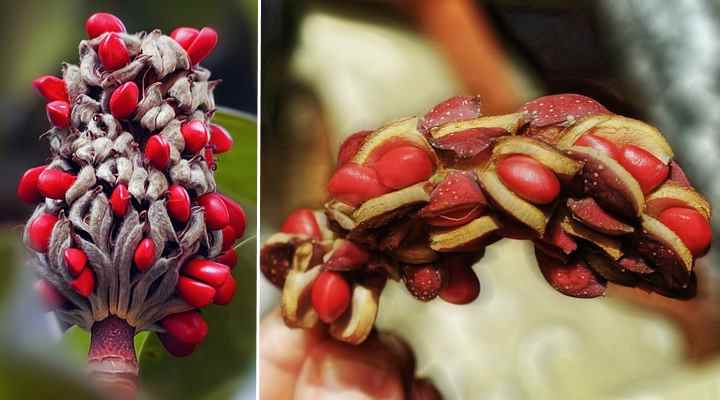
Magnolia seeds are in the bright red berries that appear in the fall. Sometimes, the seeds from magnolia trees root in the ground where they drop next to the tree. You can also propagate magnolia trees from seeds. However, growing magnolias from seed is a tricky, drawn-out process and not always successful.
Diseases Affecting Magnolia Tree and Shrub Growth
Magnolia trees and shrubs are generally hardy landscape plants that are not prone to disease. However, fungal or bacterial diseases can cause leaf spot. Also, tree canker is another type of disease that can affect stressed magnolias. Most magnolia tree infections only affect the look of the tree and are rarely serious.
Magnolia Care – FAQs
Although magnolia trees are generally easy to care for, there can be a few issues affecting their growth. Here are solutions to some problems associated with growing magnolias.
Why are magnolia leaves turning yellow?
Yellow leaves on magnolia trees can be part of the natural growth cycle. Older leaves turn yellow before dropping. If there’s new leaf growth in their place, you have nothing to worry about.
Other reasons why a magnolia tree can look as if it’s dying is due to watering issues, sun exposure, or the wrong pH levels in the soil. Too much or too little water can turn magnolia leaves yellow if the roots are stressed or drowning. Always make sure the soil is slightly moist but never too dry or soggy.
If you suspect that soil quality is to blame, use a pH tester to check for acidity. Magnolias prefer neutral to slightly acidic soil. If pH levels are too high or low, you may have to consider amending the soil.
Related reading: Learn how peat moss can help amend soil.
Why are magnolia flower buds not opening?
Lack of sunlight and nitrogen issues are two reasons why magnolia buds don’t open. If the magnolia shrub or tree is in too much shade, the buds may appear but fail to open. Similarly, too much nitrogen in the ground can cause buds to stay shut rather than open.
Magnolia buds are also susceptible to frost. So, if you experience a late spring frost, the buds won’t open but fall from the tree.
Another reason for buds failing to open is if your magnolia tree has a thrip infestation. Check the tree leaves for signs of thrips and use a neem oil solution to rid the tree of the sap-sucking creatures.
Why doesn’t my magnolia tree flower?
Magnolia trees can fail to bloom if the climate is too cold. Magnolias are sensitive to cold weather. Even if the trees are growing in the right zone, an unseasonal cold snap can affect magnolia blooming habits, and your tree will then fail to produce flowers.
Other reasons why magnolias don’t bloom are too little sunlight or growing in alkaline soil.
How fast do magnolia trees grow?
Magnolia is a plant that typically has slow to medium growth. Expect a magnolia tree or shrub to grow between 1 and 2 ft. (30 – 60 cm) a year, but only if growing conditions are ideal. In time, magnolias grow a large, extensive shade canopy that can be as large as the shrub or tree is tall.
My magnolia tree leaves have black spots, what should I do?
Dark spots on magnolia tree leaves can be due to pest damage or disease. Some black or dark brown leaf spots could be signs of bacterial or fungal infections. These diseases tend to occur in humid or rainy weather.
Try pruning the branches to thin out the foliage and increase air circulation to resolve the issue.
Be careful of invasive magnolia roots
When deciding where to plant a magnolia, don’t plant too close to your house. Large magnolia species such as the Southern Magnolia (Magnolia grandiflora) can have a root spread up to 40 ft. (12 m) from the tree trunk.
Magnolias have a shallow root system. They can cause damage to foundations and water pipes if planted too close to buildings.
Types of Magnolia
Southern Magnolia (Magnolia grandiflora) – The stunning Southern Magnolia is evergreen in zones 7 through 9. This species grows between 60 and 80 ft. (18 – 24 m) tall and has large white flowers up to 8” (20 cm) across.
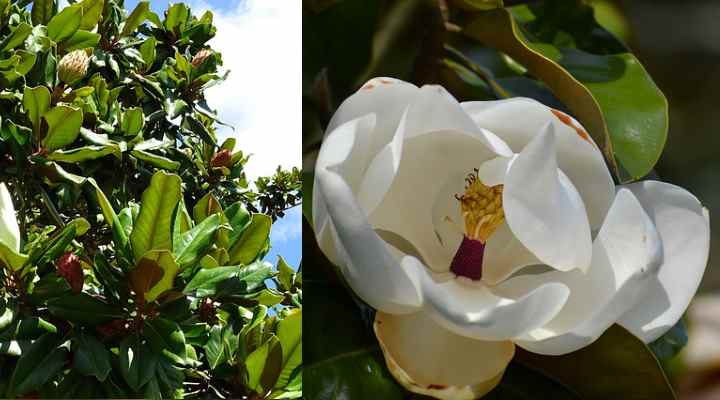
Southern Magnolia (Magnolia grandiflora)
Saucer Magnolia (Magnolia x soulangeana) – This deciduous magnolia variety is one of the most popular landscaping plants. The large shrub or tree produces pink, fragrant, bowl-shaped flowers that are up to 10” (25 cm) across.
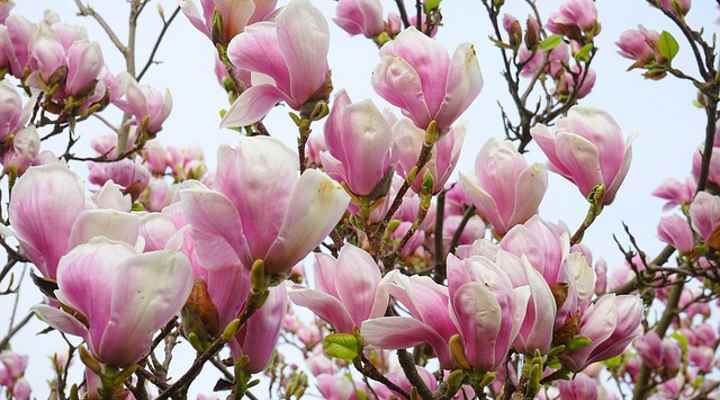
Saucer Magnolia (Magnolia x soulangeana)
Magnolia x loebneri – This dwarf magnolia tree grows between 8 and 15 ft. (2 – 5 m) with a similar spread. The white fragrant, star-shaped flowers have long, thin petals with hints of light pink.

Magnolia x loebneri ‘Spring Snow’
Black Lily Magnolia (Magnolia liliiflora) — The Black Lily is a large magnolia shrub with lush, green foliage and a rounded crown. The tulip-like flowers are dark pink and grow up to 5” (12 cm) long.
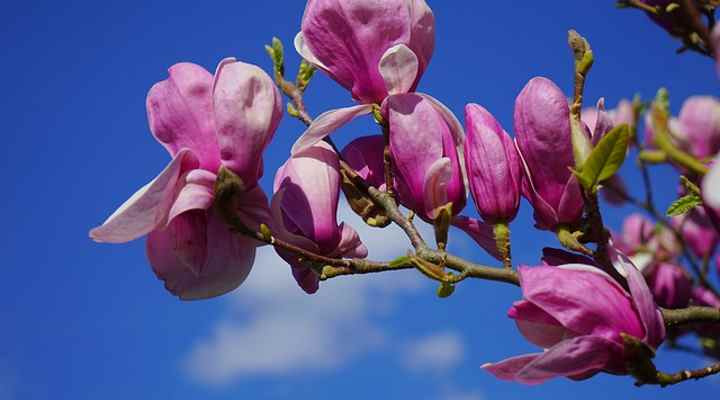
Black Lily Magnolia (Magnolia liliiflora)
Pink Stardust Magnolia (Magnolia stellata ‘Pink Stardust’) — This small magnolia shrub is suitable for planting in small gardens or containers. The shrub explodes with white and pink flowers to add plenty of color to a spring garden.
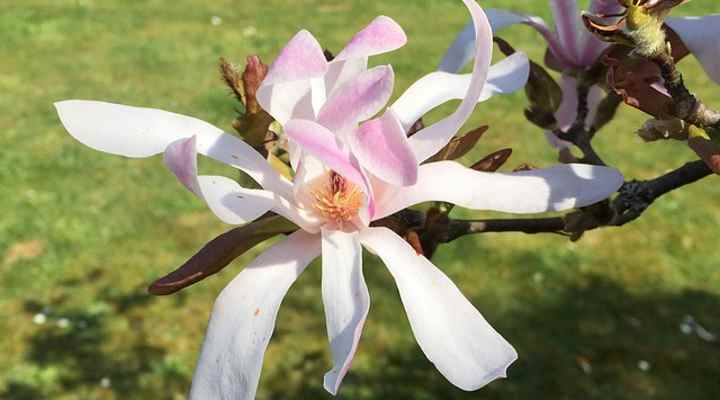
Pink Stardust Magnolia
Discover the most beautiful types of magnolia trees and shrubs.
Related articles:
- Types of Flowering Trees with Pictures
- Small Trees for Landscaping Small Spaces
- Types of Cherry Blossom Trees
